CHC50113 Diploma of Early Childhood Education: Child Abuse Report
VerifiedAdded on 2023/04/20
|7
|1412
|458
Report
AI Summary
This report addresses child abuse within the context of early childhood education, covering various forms of abuse, including physical, sexual, and psychological maltreatment. It explores the challenges of identifying domestic violence, and outlines six potential signs of abuse observable in early childhood settings. The report provides guidance on actions to take when child abuse is suspected, emphasizing continuous communication with the child, maintaining detailed records, and seeking support from trusted sources. It highlights the importance of accurate and objective documentation and the need to maintain confidentiality. The report also provides examples of open, non-leading questions to use when a child discloses abuse, and discusses how educators can protect themselves from false claims. Finally, it outlines four child-focused practices, including involving children in decision-making, believing the child, promoting their rights, and fostering positive experiences. This report is a valuable resource for students studying for their CHC50113 Diploma of Early Childhood Education and Care.
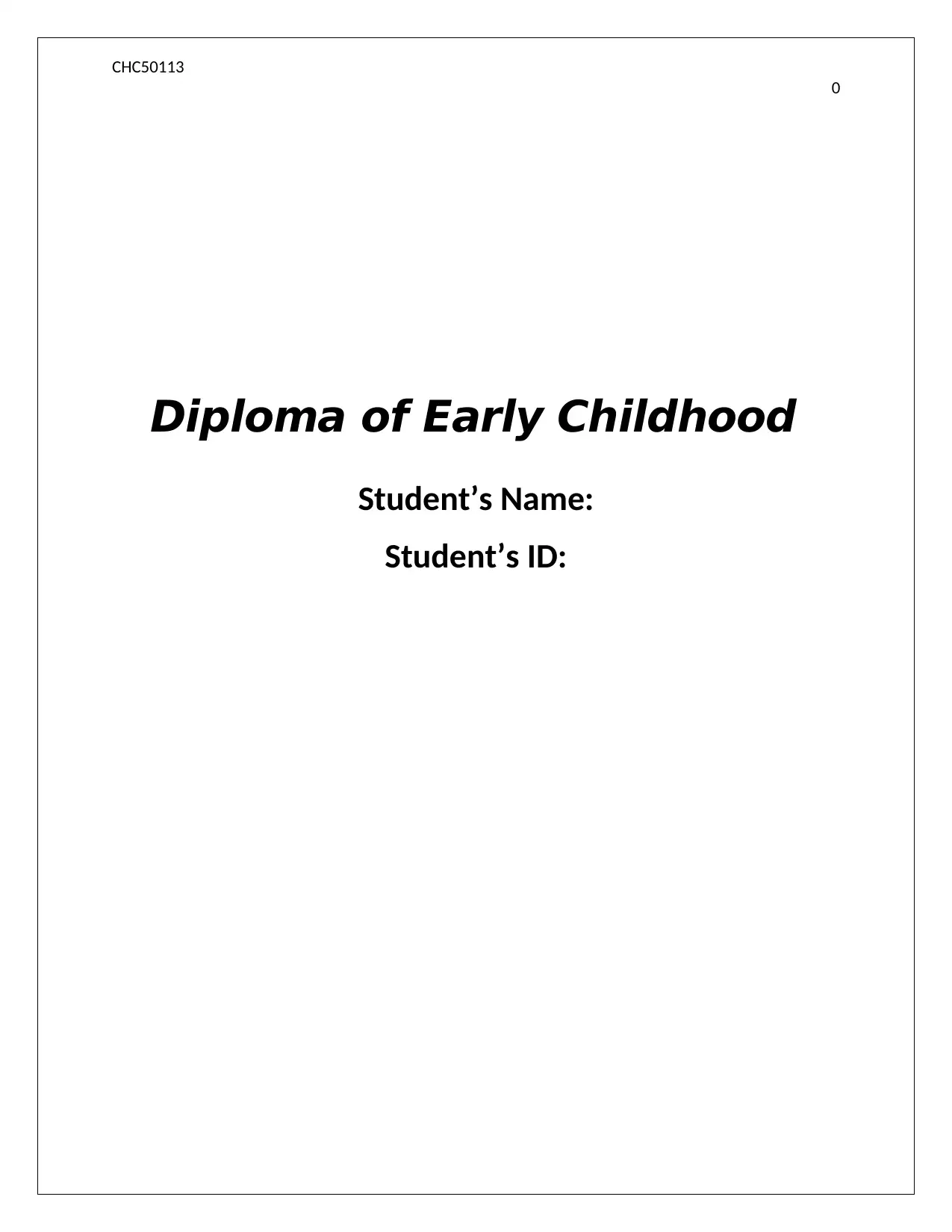
CHC50113
0
Diploma of Early Childhood
Student’s Name:
Student’s ID:
0
Diploma of Early Childhood
Student’s Name:
Student’s ID:
Paraphrase This Document
Need a fresh take? Get an instant paraphrase of this document with our AI Paraphraser
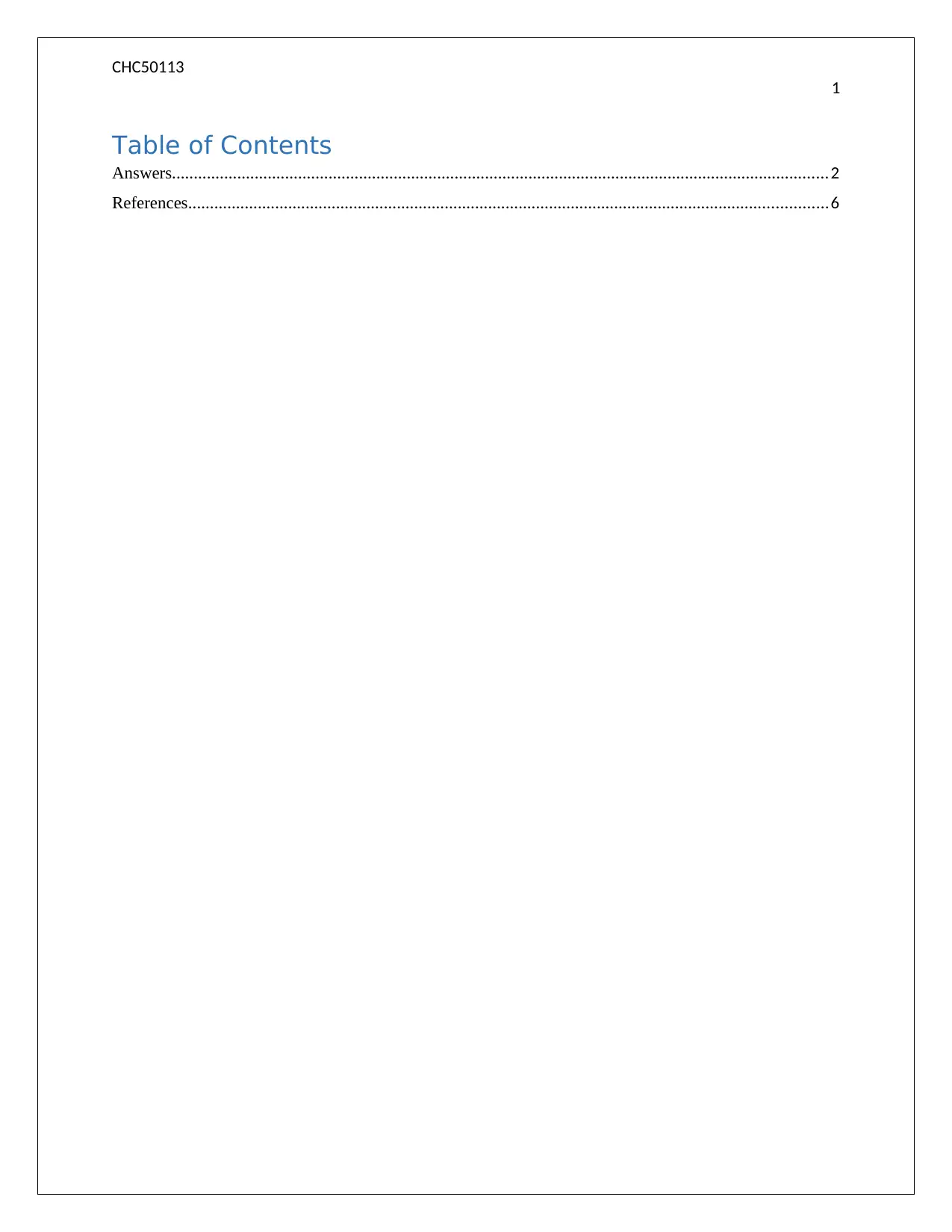
CHC50113
1
Table of Contents
Answers.......................................................................................................................................................2
References...................................................................................................................................................6
1
Table of Contents
Answers.......................................................................................................................................................2
References...................................................................................................................................................6
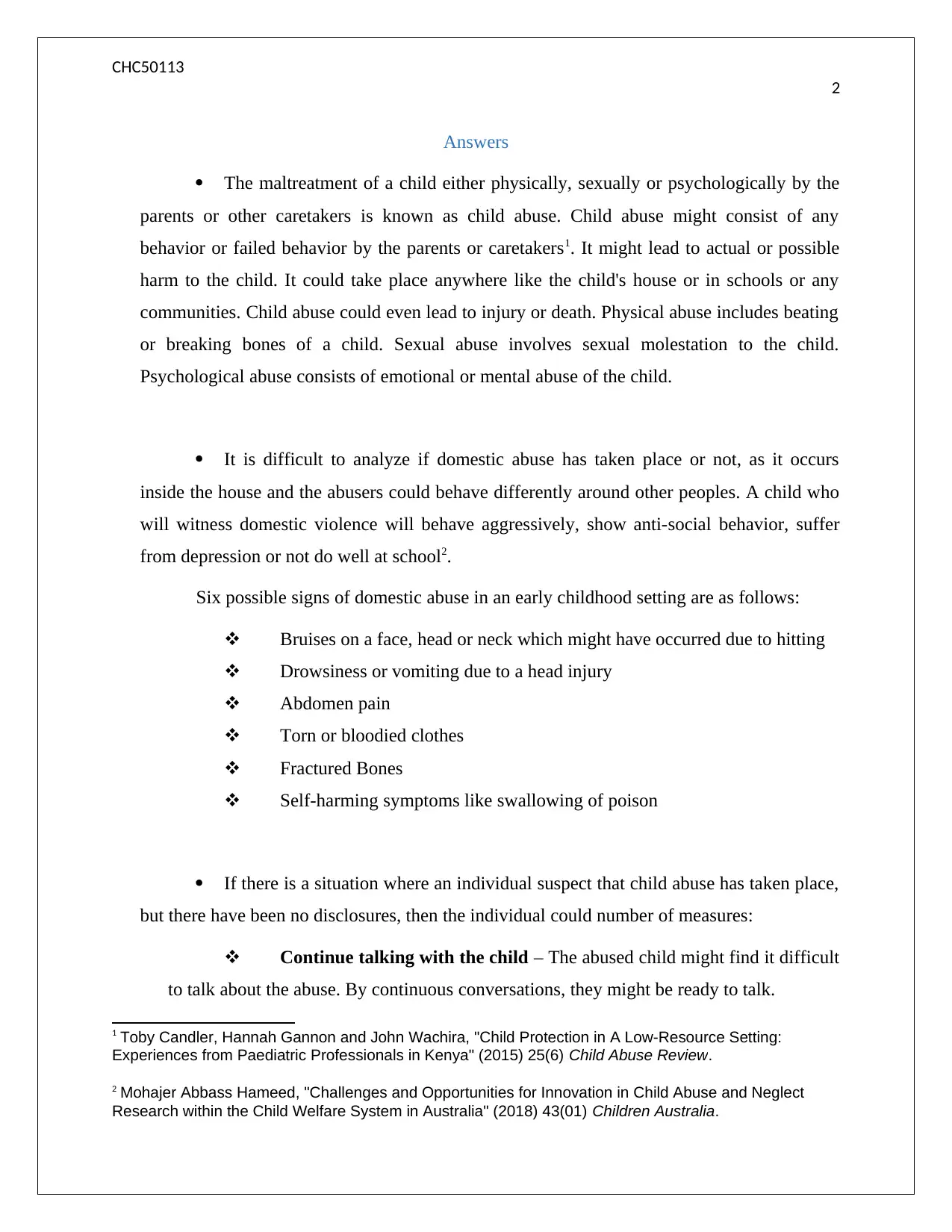
CHC50113
2
Answers
The maltreatment of a child either physically, sexually or psychologically by the
parents or other caretakers is known as child abuse. Child abuse might consist of any
behavior or failed behavior by the parents or caretakers1. It might lead to actual or possible
harm to the child. It could take place anywhere like the child's house or in schools or any
communities. Child abuse could even lead to injury or death. Physical abuse includes beating
or breaking bones of a child. Sexual abuse involves sexual molestation to the child.
Psychological abuse consists of emotional or mental abuse of the child.
It is difficult to analyze if domestic abuse has taken place or not, as it occurs
inside the house and the abusers could behave differently around other peoples. A child who
will witness domestic violence will behave aggressively, show anti-social behavior, suffer
from depression or not do well at school2.
Six possible signs of domestic abuse in an early childhood setting are as follows:
Bruises on a face, head or neck which might have occurred due to hitting
Drowsiness or vomiting due to a head injury
Abdomen pain
Torn or bloodied clothes
Fractured Bones
Self-harming symptoms like swallowing of poison
If there is a situation where an individual suspect that child abuse has taken place,
but there have been no disclosures, then the individual could number of measures:
Continue talking with the child – The abused child might find it difficult
to talk about the abuse. By continuous conversations, they might be ready to talk.
1 Toby Candler, Hannah Gannon and John Wachira, "Child Protection in A Low-Resource Setting:
Experiences from Paediatric Professionals in Kenya" (2015) 25(6) Child Abuse Review.
2 Mohajer Abbass Hameed, "Challenges and Opportunities for Innovation in Child Abuse and Neglect
Research within the Child Welfare System in Australia" (2018) 43(01) Children Australia.
2
Answers
The maltreatment of a child either physically, sexually or psychologically by the
parents or other caretakers is known as child abuse. Child abuse might consist of any
behavior or failed behavior by the parents or caretakers1. It might lead to actual or possible
harm to the child. It could take place anywhere like the child's house or in schools or any
communities. Child abuse could even lead to injury or death. Physical abuse includes beating
or breaking bones of a child. Sexual abuse involves sexual molestation to the child.
Psychological abuse consists of emotional or mental abuse of the child.
It is difficult to analyze if domestic abuse has taken place or not, as it occurs
inside the house and the abusers could behave differently around other peoples. A child who
will witness domestic violence will behave aggressively, show anti-social behavior, suffer
from depression or not do well at school2.
Six possible signs of domestic abuse in an early childhood setting are as follows:
Bruises on a face, head or neck which might have occurred due to hitting
Drowsiness or vomiting due to a head injury
Abdomen pain
Torn or bloodied clothes
Fractured Bones
Self-harming symptoms like swallowing of poison
If there is a situation where an individual suspect that child abuse has taken place,
but there have been no disclosures, then the individual could number of measures:
Continue talking with the child – The abused child might find it difficult
to talk about the abuse. By continuous conversations, they might be ready to talk.
1 Toby Candler, Hannah Gannon and John Wachira, "Child Protection in A Low-Resource Setting:
Experiences from Paediatric Professionals in Kenya" (2015) 25(6) Child Abuse Review.
2 Mohajer Abbass Hameed, "Challenges and Opportunities for Innovation in Child Abuse and Neglect
Research within the Child Welfare System in Australia" (2018) 43(01) Children Australia.
⊘ This is a preview!⊘
Do you want full access?
Subscribe today to unlock all pages.

Trusted by 1+ million students worldwide
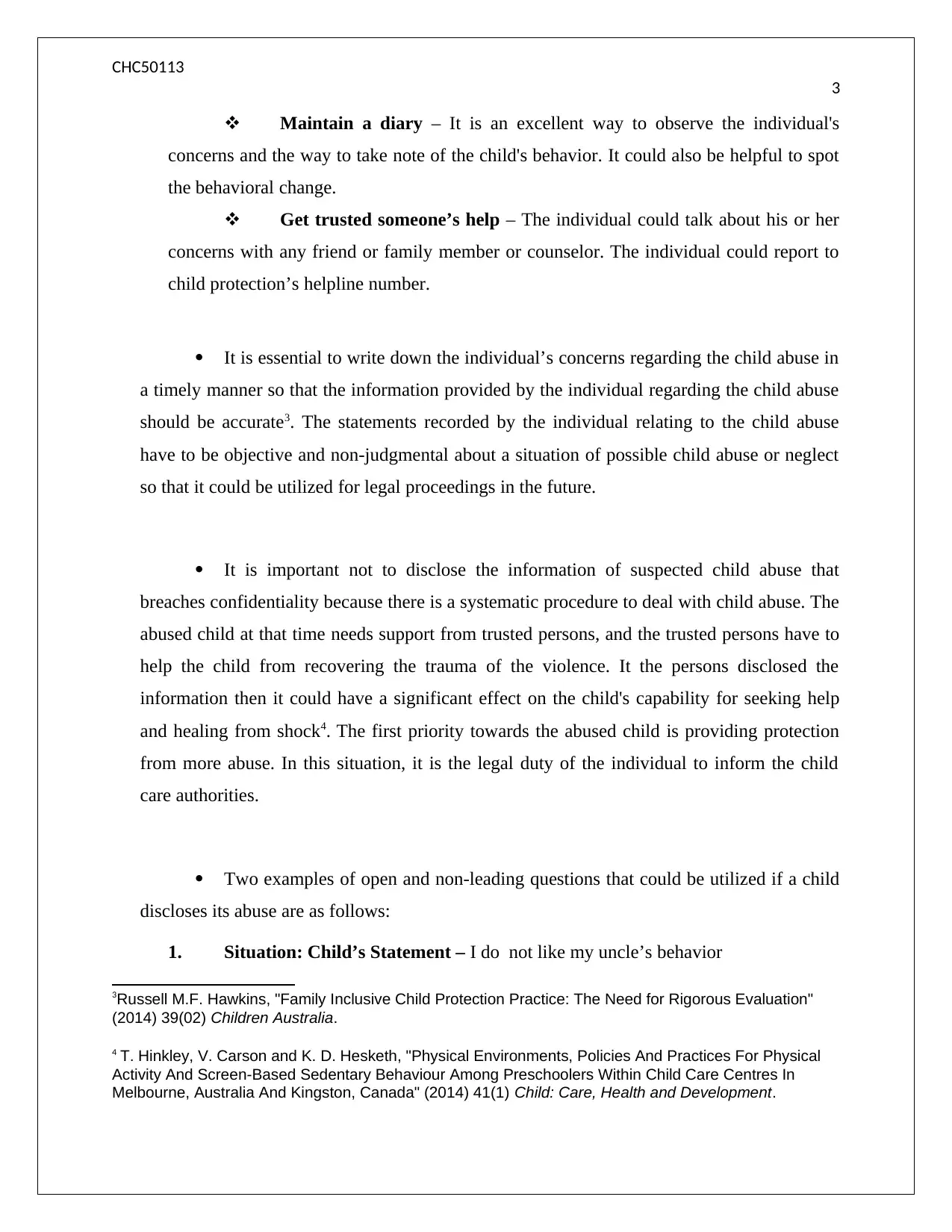
CHC50113
3
Maintain a diary – It is an excellent way to observe the individual's
concerns and the way to take note of the child's behavior. It could also be helpful to spot
the behavioral change.
Get trusted someone’s help – The individual could talk about his or her
concerns with any friend or family member or counselor. The individual could report to
child protection’s helpline number.
It is essential to write down the individual’s concerns regarding the child abuse in
a timely manner so that the information provided by the individual regarding the child abuse
should be accurate3. The statements recorded by the individual relating to the child abuse
have to be objective and non-judgmental about a situation of possible child abuse or neglect
so that it could be utilized for legal proceedings in the future.
It is important not to disclose the information of suspected child abuse that
breaches confidentiality because there is a systematic procedure to deal with child abuse. The
abused child at that time needs support from trusted persons, and the trusted persons have to
help the child from recovering the trauma of the violence. It the persons disclosed the
information then it could have a significant effect on the child's capability for seeking help
and healing from shock4. The first priority towards the abused child is providing protection
from more abuse. In this situation, it is the legal duty of the individual to inform the child
care authorities.
Two examples of open and non-leading questions that could be utilized if a child
discloses its abuse are as follows:
1. Situation: Child’s Statement – I do not like my uncle’s behavior
3Russell M.F. Hawkins, "Family Inclusive Child Protection Practice: The Need for Rigorous Evaluation"
(2014) 39(02) Children Australia.
4 T. Hinkley, V. Carson and K. D. Hesketh, "Physical Environments, Policies And Practices For Physical
Activity And Screen-Based Sedentary Behaviour Among Preschoolers Within Child Care Centres In
Melbourne, Australia And Kingston, Canada" (2014) 41(1) Child: Care, Health and Development.
3
Maintain a diary – It is an excellent way to observe the individual's
concerns and the way to take note of the child's behavior. It could also be helpful to spot
the behavioral change.
Get trusted someone’s help – The individual could talk about his or her
concerns with any friend or family member or counselor. The individual could report to
child protection’s helpline number.
It is essential to write down the individual’s concerns regarding the child abuse in
a timely manner so that the information provided by the individual regarding the child abuse
should be accurate3. The statements recorded by the individual relating to the child abuse
have to be objective and non-judgmental about a situation of possible child abuse or neglect
so that it could be utilized for legal proceedings in the future.
It is important not to disclose the information of suspected child abuse that
breaches confidentiality because there is a systematic procedure to deal with child abuse. The
abused child at that time needs support from trusted persons, and the trusted persons have to
help the child from recovering the trauma of the violence. It the persons disclosed the
information then it could have a significant effect on the child's capability for seeking help
and healing from shock4. The first priority towards the abused child is providing protection
from more abuse. In this situation, it is the legal duty of the individual to inform the child
care authorities.
Two examples of open and non-leading questions that could be utilized if a child
discloses its abuse are as follows:
1. Situation: Child’s Statement – I do not like my uncle’s behavior
3Russell M.F. Hawkins, "Family Inclusive Child Protection Practice: The Need for Rigorous Evaluation"
(2014) 39(02) Children Australia.
4 T. Hinkley, V. Carson and K. D. Hesketh, "Physical Environments, Policies And Practices For Physical
Activity And Screen-Based Sedentary Behaviour Among Preschoolers Within Child Care Centres In
Melbourne, Australia And Kingston, Canada" (2014) 41(1) Child: Care, Health and Development.
Paraphrase This Document
Need a fresh take? Get an instant paraphrase of this document with our AI Paraphraser
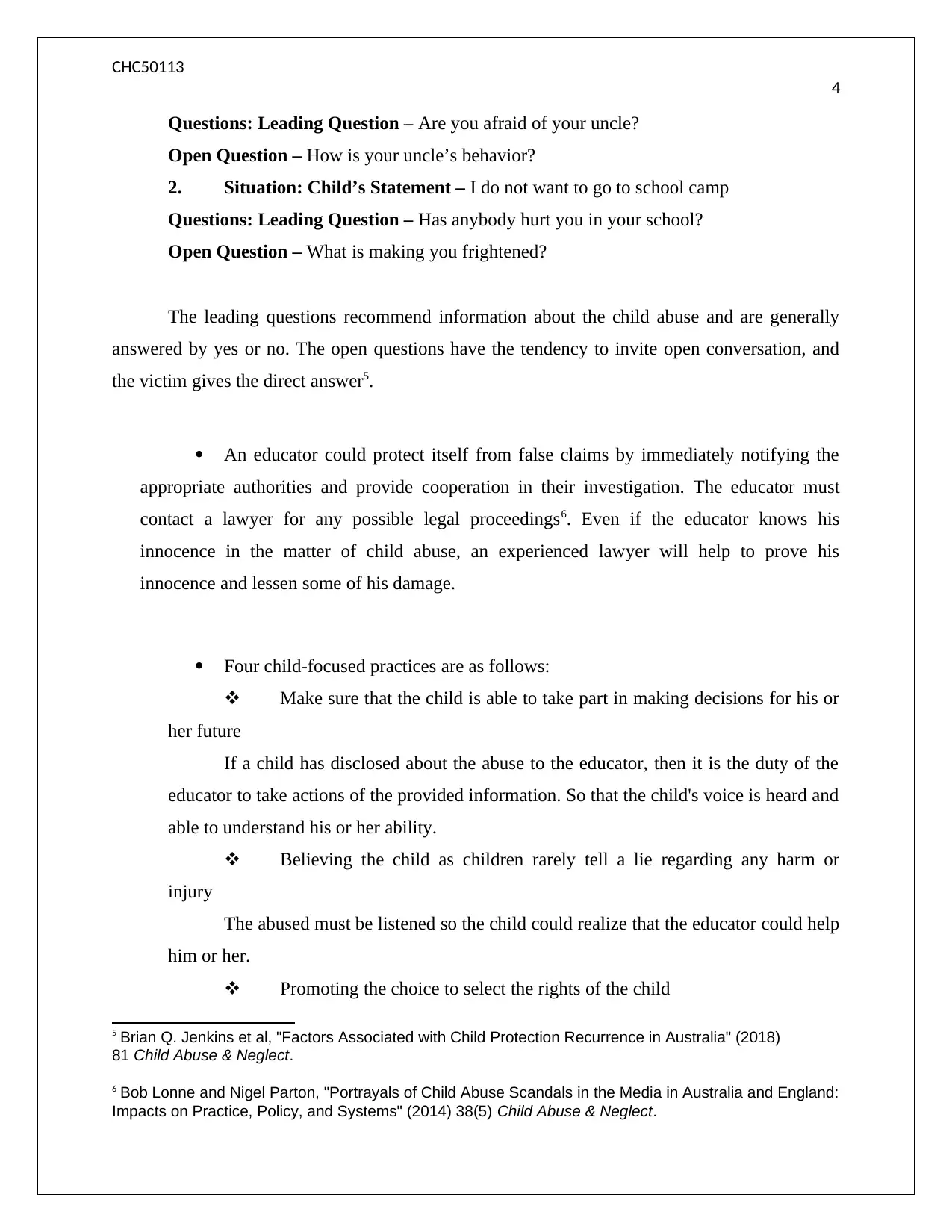
CHC50113
4
Questions: Leading Question – Are you afraid of your uncle?
Open Question – How is your uncle’s behavior?
2. Situation: Child’s Statement – I do not want to go to school camp
Questions: Leading Question – Has anybody hurt you in your school?
Open Question – What is making you frightened?
The leading questions recommend information about the child abuse and are generally
answered by yes or no. The open questions have the tendency to invite open conversation, and
the victim gives the direct answer5.
An educator could protect itself from false claims by immediately notifying the
appropriate authorities and provide cooperation in their investigation. The educator must
contact a lawyer for any possible legal proceedings6. Even if the educator knows his
innocence in the matter of child abuse, an experienced lawyer will help to prove his
innocence and lessen some of his damage.
Four child-focused practices are as follows:
Make sure that the child is able to take part in making decisions for his or
her future
If a child has disclosed about the abuse to the educator, then it is the duty of the
educator to take actions of the provided information. So that the child's voice is heard and
able to understand his or her ability.
Believing the child as children rarely tell a lie regarding any harm or
injury
The abused must be listened so the child could realize that the educator could help
him or her.
Promoting the choice to select the rights of the child
5 Brian Q. Jenkins et al, "Factors Associated with Child Protection Recurrence in Australia" (2018)
81 Child Abuse & Neglect.
6 Bob Lonne and Nigel Parton, "Portrayals of Child Abuse Scandals in the Media in Australia and England:
Impacts on Practice, Policy, and Systems" (2014) 38(5) Child Abuse & Neglect.
4
Questions: Leading Question – Are you afraid of your uncle?
Open Question – How is your uncle’s behavior?
2. Situation: Child’s Statement – I do not want to go to school camp
Questions: Leading Question – Has anybody hurt you in your school?
Open Question – What is making you frightened?
The leading questions recommend information about the child abuse and are generally
answered by yes or no. The open questions have the tendency to invite open conversation, and
the victim gives the direct answer5.
An educator could protect itself from false claims by immediately notifying the
appropriate authorities and provide cooperation in their investigation. The educator must
contact a lawyer for any possible legal proceedings6. Even if the educator knows his
innocence in the matter of child abuse, an experienced lawyer will help to prove his
innocence and lessen some of his damage.
Four child-focused practices are as follows:
Make sure that the child is able to take part in making decisions for his or
her future
If a child has disclosed about the abuse to the educator, then it is the duty of the
educator to take actions of the provided information. So that the child's voice is heard and
able to understand his or her ability.
Believing the child as children rarely tell a lie regarding any harm or
injury
The abused must be listened so the child could realize that the educator could help
him or her.
Promoting the choice to select the rights of the child
5 Brian Q. Jenkins et al, "Factors Associated with Child Protection Recurrence in Australia" (2018)
81 Child Abuse & Neglect.
6 Bob Lonne and Nigel Parton, "Portrayals of Child Abuse Scandals in the Media in Australia and England:
Impacts on Practice, Policy, and Systems" (2014) 38(5) Child Abuse & Neglect.
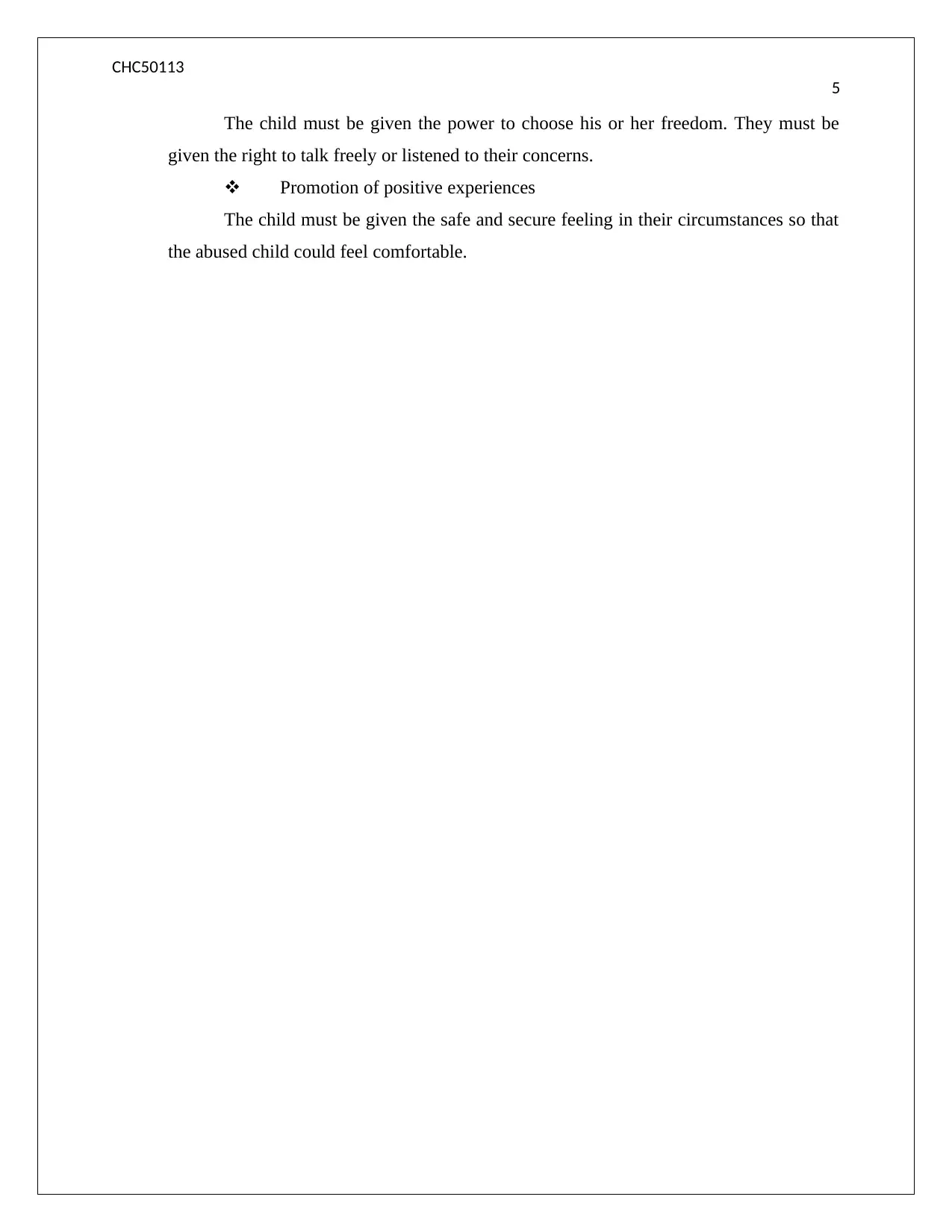
CHC50113
5
The child must be given the power to choose his or her freedom. They must be
given the right to talk freely or listened to their concerns.
Promotion of positive experiences
The child must be given the safe and secure feeling in their circumstances so that
the abused child could feel comfortable.
5
The child must be given the power to choose his or her freedom. They must be
given the right to talk freely or listened to their concerns.
Promotion of positive experiences
The child must be given the safe and secure feeling in their circumstances so that
the abused child could feel comfortable.
⊘ This is a preview!⊘
Do you want full access?
Subscribe today to unlock all pages.

Trusted by 1+ million students worldwide
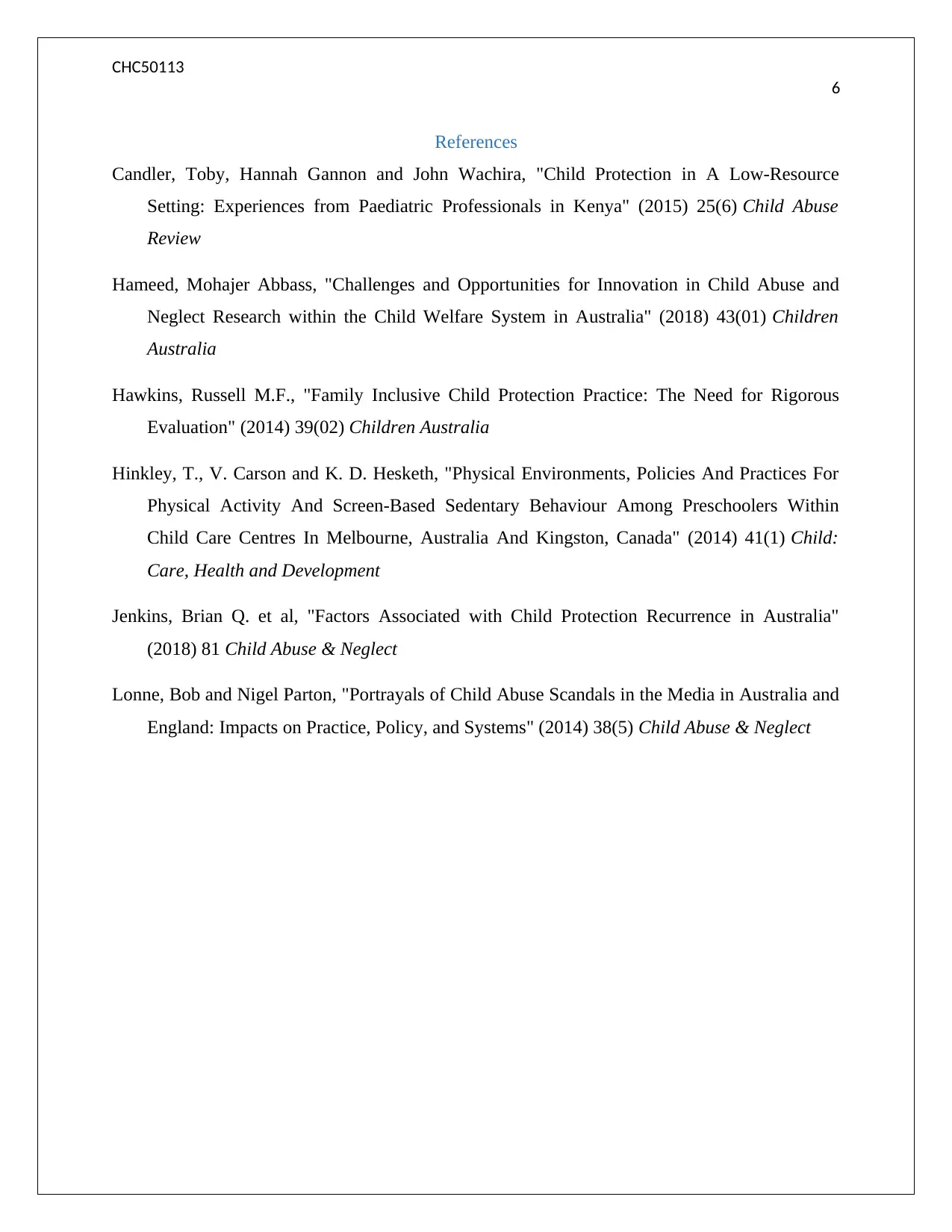
CHC50113
6
References
Candler, Toby, Hannah Gannon and John Wachira, "Child Protection in A Low-Resource
Setting: Experiences from Paediatric Professionals in Kenya" (2015) 25(6) Child Abuse
Review
Hameed, Mohajer Abbass, "Challenges and Opportunities for Innovation in Child Abuse and
Neglect Research within the Child Welfare System in Australia" (2018) 43(01) Children
Australia
Hawkins, Russell M.F., "Family Inclusive Child Protection Practice: The Need for Rigorous
Evaluation" (2014) 39(02) Children Australia
Hinkley, T., V. Carson and K. D. Hesketh, "Physical Environments, Policies And Practices For
Physical Activity And Screen-Based Sedentary Behaviour Among Preschoolers Within
Child Care Centres In Melbourne, Australia And Kingston, Canada" (2014) 41(1) Child:
Care, Health and Development
Jenkins, Brian Q. et al, "Factors Associated with Child Protection Recurrence in Australia"
(2018) 81 Child Abuse & Neglect
Lonne, Bob and Nigel Parton, "Portrayals of Child Abuse Scandals in the Media in Australia and
England: Impacts on Practice, Policy, and Systems" (2014) 38(5) Child Abuse & Neglect
6
References
Candler, Toby, Hannah Gannon and John Wachira, "Child Protection in A Low-Resource
Setting: Experiences from Paediatric Professionals in Kenya" (2015) 25(6) Child Abuse
Review
Hameed, Mohajer Abbass, "Challenges and Opportunities for Innovation in Child Abuse and
Neglect Research within the Child Welfare System in Australia" (2018) 43(01) Children
Australia
Hawkins, Russell M.F., "Family Inclusive Child Protection Practice: The Need for Rigorous
Evaluation" (2014) 39(02) Children Australia
Hinkley, T., V. Carson and K. D. Hesketh, "Physical Environments, Policies And Practices For
Physical Activity And Screen-Based Sedentary Behaviour Among Preschoolers Within
Child Care Centres In Melbourne, Australia And Kingston, Canada" (2014) 41(1) Child:
Care, Health and Development
Jenkins, Brian Q. et al, "Factors Associated with Child Protection Recurrence in Australia"
(2018) 81 Child Abuse & Neglect
Lonne, Bob and Nigel Parton, "Portrayals of Child Abuse Scandals in the Media in Australia and
England: Impacts on Practice, Policy, and Systems" (2014) 38(5) Child Abuse & Neglect
1 out of 7
Related Documents
Your All-in-One AI-Powered Toolkit for Academic Success.
+13062052269
info@desklib.com
Available 24*7 on WhatsApp / Email
![[object Object]](/_next/static/media/star-bottom.7253800d.svg)
Unlock your academic potential
Copyright © 2020–2025 A2Z Services. All Rights Reserved. Developed and managed by ZUCOL.





